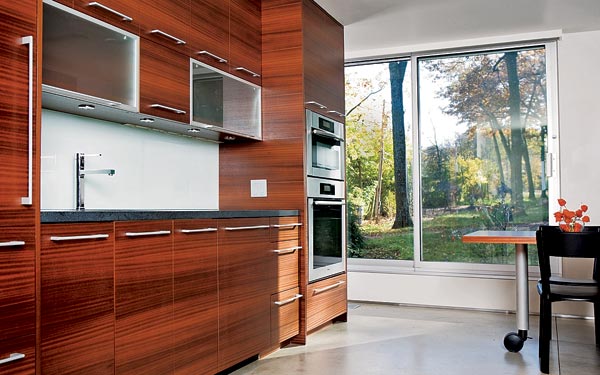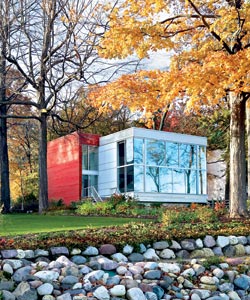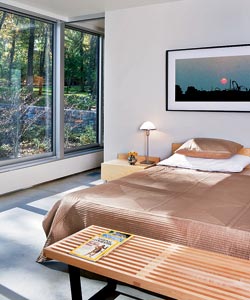
The anodized-aluminum base complements the frames of the sliding doors. The kitchen is elegant in mahogany.� Photo Gallery:::
One event led to another, the stars aligned, and now David Weinberg is having the time of his life all the time.”To be able to combine being in a beautiful place and doing something that gives you a lot of pleasure is the best of all worlds,” Weinberg says,”and that’s what this is all about.” What this is really about is the photography studio that Weinberg and his wife, Jerry Newton, a lawyer, completed a year and a half ago next door to their weekend house in Lake Geneva, Wisconsin.
Weinberg spent 35 years in business at Fel-Pro, a Skokie-based automotive-parts manufacturer founded by his grandfather in 1918. After selling Fel-Pro in the late nineties, Weinberg worked as a consultant for three years.”Then I decided that what I wanted to do was follow my real passion, which was photography,” he explains. He began studying with other photographers and also opened an eponymously named gallery in 2006 at 300 West Superior Street, where he has displayed his own work as well as that of almost 30 other artists.
 |
Newton and Weinberg have been married for 18 years—this is a second marriage for both—and together they have four children and six grandchildren. Their principal residence is a graystone in Lincoln Park; they bought their modern stucco house in Lake Geneva (an hour-and-a-half drive from Chicago) about 13 years ago, and when the Victorian house in ill repair next door was put on the market in 2005, they decided to buy it, too.
“We didn’t want somebody moving in and destroying our peace and quiet,” Newton says.”So it was partly to protect where we lived, and it was partly for investment. David really wanted a studio and has become very serious with his photography, and I’m his wife, so of course I think it’s good. But other people say it’s very good, so maybe it actually is. This is something he’s wanted to do, and it has turned out to be a beautiful home.”
Newton and Weinberg live well and travel extensively, and yet both are committed contributors. In her law practice, Newton specializes in cases of employment discrimination. She is the chair of the board of Personal PAC, a single-issue not-for-profit organization in Illinois that supports candidates for election who are pro-choice. Newton is also on the board of Planned Parenthood and is actively involved with Human Rights Watch and the American Civil Liberties Union. And she is a big fan of the Obamas. She worked on Barack’s senatorial campaign and recently traveled to South Carolina, Ohio, and Pennsylvania to support him in the primaries. Weinberg is involved in the charter-school movement and holds events at his gallery to educate students about fine art.
And when it comes to relationships, Newton and Weinberg are obviously loyal. Ken Schroeder, a principal of the Chicago firm Schroeder Murchie Niemiec Gazda-Auskalnis Architects, had restored their graystone in the early nineties, and Newton and Weinberg were pleased with the results, so they went back to him to discuss their new project. They all agreed that the existing structure was unsalvageable.

The George Nelson bench and the Case Study bed and end tables are maple. Above the |
“We wanted the studio to have its own personality,” Weinberg says,”but also to tie in with the house so there was some continuity.” At first, Schroeder recalls, Weinberg was thinking simply and industrially:”He said he wanted to buy a prefab off-the-shelf box and set it on the site. We looked at a couple of prefab ideas, but they didn’t have the kind of spatial qualities that he was looking for.” Weinberg wanted a two-story studio space, which wasn’t possible with a prefab. Still, the architect and the clients agreed to pursue an industrial aesthetic and a boxlike design. To complement the white stucco of their house, Schroeder suggested cement panels with exposed stainless-steel fasteners for the studio. The top and bottom of the exterior are stained cedar. Both the house and the studio have flat roofs.
The Victorian house on the site had been oddly closed off to the lakefront.”There were some really small windows,” explains Molly Kinsella, one of the project architects.”You had this phenomenal view, and you didn’t even know the lake was there. It was sad.”
By saving the foundation of the old house, they could maintain the existing setbacks and build a structure of the same size.”We used the ghost of the Victorian house to define the edges,” Schroeder says, putting an eerie 19th-century spin on what would be superseded by a pristine 2,900-square-foot structure overlooking blue water and towering trees.
As the project moved along, the box evolved.”Budgets are always an issue, but this is a playhouse, and ‘no’ was not on the table very often,” Schroeder says.”When you’re building a playhouse it’s always kind of ‘yes, yes, yes.'” A red wall on the east side defines the entrance and provides privacy—the view goes straight through from the foyer to the lake beyond. Running parallel on the other side of the house is an old stone wall that at one time marked the border of a large estate. The ceiling in the two-story studio is made of industrial joists and steel decking, the stair rails are stainless steel, and the floor is concrete. Equally spare are the furnishings—a pair of racy red Womb chairs and a Tulip table by Eero Saarinen on a multicolored Slade rug, all from Design Within Reach. A desk against one wall holds a digital lab that is linked to other equipment in Weinberg’s gallery office and his house in Lincoln Park.
Completing the first floor are the kitchen, dining room, bedroom, and bath. Newton and Weinberg also use the studio as a guesthouse. What was originally in-tended to be a small kitchen became bigger, elegant, and shiplike in mahogany. Upstairs are a large gallery and a porch; the latter, Weinberg says, is Newton’s official designated reading area. But she reserves the right to roam.”I can do what I want,” she says.”It’s my house as much as it is his. A lot of it was designed and decorated in my taste, so it’s not his; it’s ours—no question about that.”
In the front of the house, Newton and Weinberg planted a prairie.”Some of the farmland in Lake Geneva is being sold off for development,” Weinberg says,”and it was our feeling that we should try to reverse that trend, at least on our property.”
If, in the future, they decide to sell the studio, it can easily be converted into a three- or four-bedroom house. For now, a sense of newness reigns.”We haven’t really felt out exactly who’s going to be where and do what,” Newton says. Weinberg seems not to believe his luck. He fills a notebook with ideas for photography projects as he dreams them up. A series of photos taken last summer, entitled Currents and Tides, hang in the upstairs gallery—Weinberg trained his infrared camera on the lake to capture abstract natural effects. Tangled webs of seaweed and leaves float on the surface of the water, buoyant and mutable. Now Weinberg is moving on to other projects—again, at long last, it’s summer.
Photography: Katrina Wittkamp Photo Styling: Taryn Bickley


